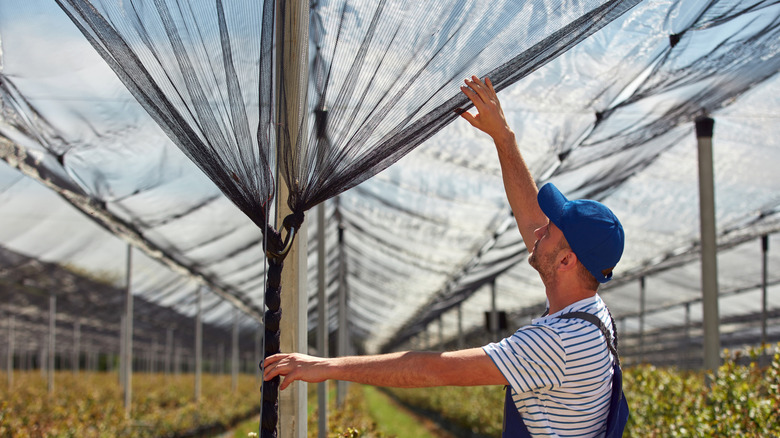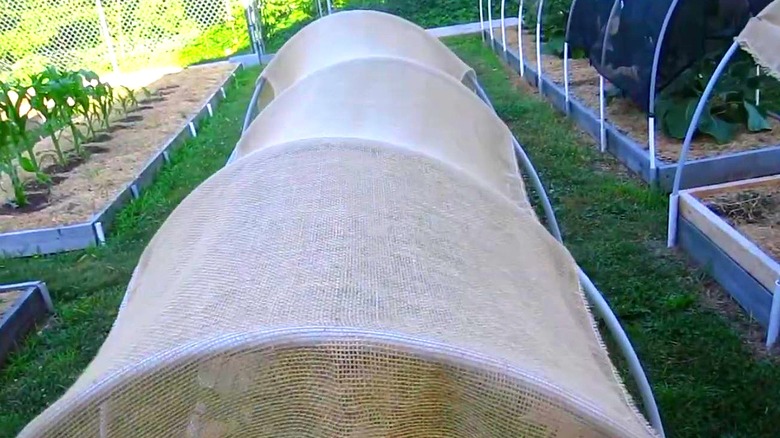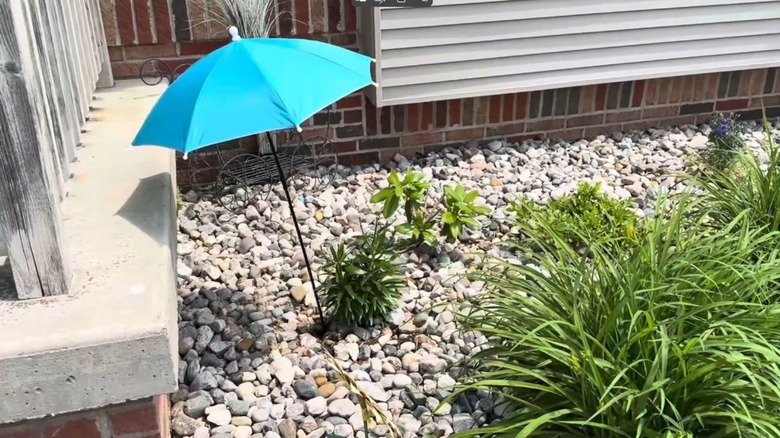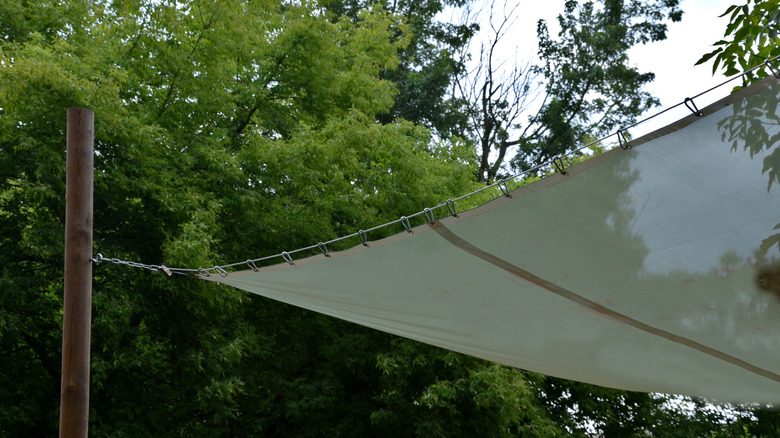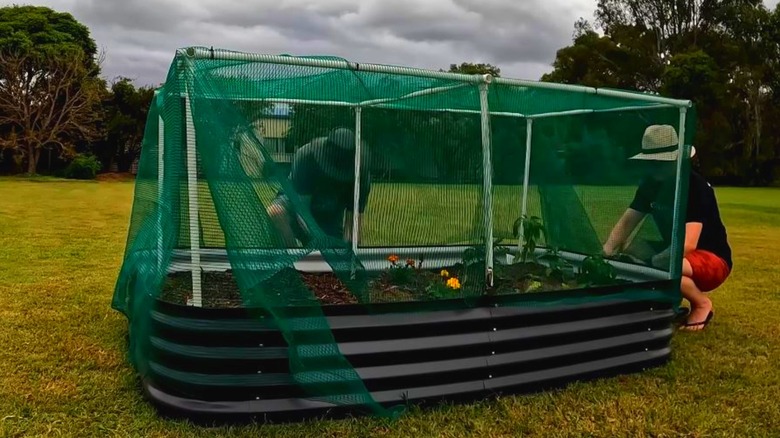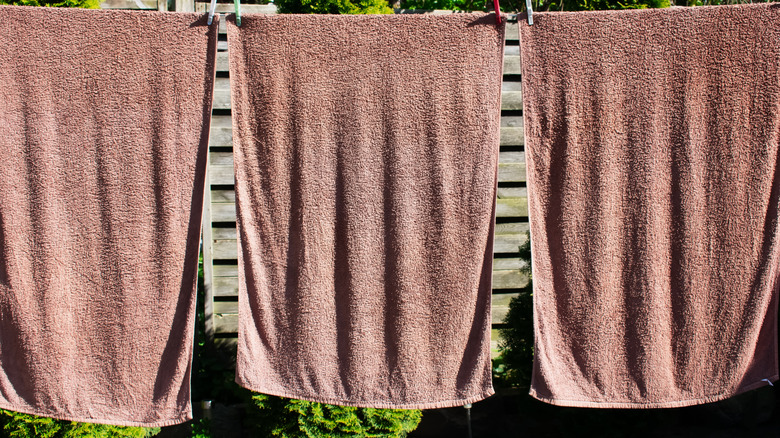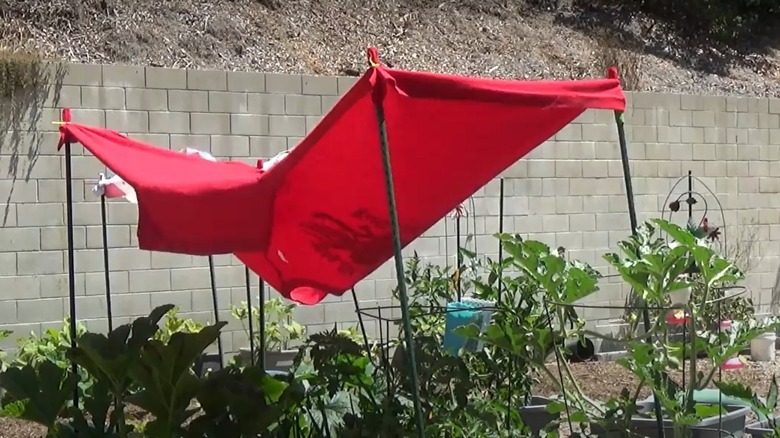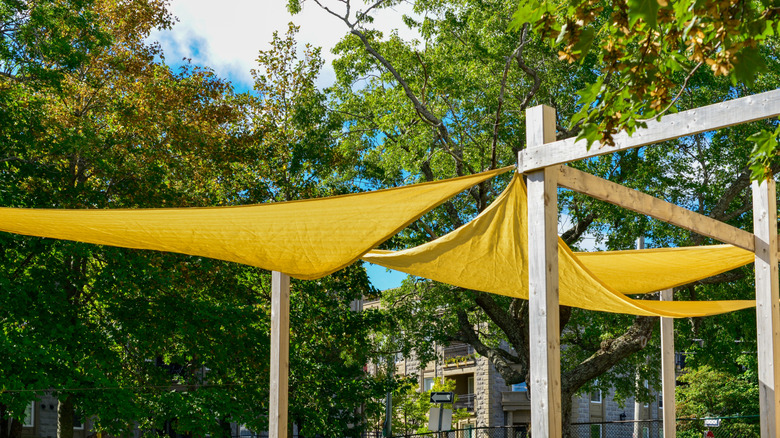10 Items You Can Reuse To Build Shade On A Budget In Your Garden
It's official: This summer is shaping up to be another record-breaker for rising temperatures. Heat waves have already swept through much of the United States, bringing with them intense UV rays and little reprieve. Especially if you're in an area that consistently sees temperatures north of 90 degrees, you may need to get creative to shade your plants from the brutally hot sun.
If you keep an eye on gardening trends online, you have no doubt come across shade cloths marketed to protect your precious plants from the sweltering sun. These large outdoor blankets are designed to filter and reflect UV rays to keep your plants more comfortable, even as temperatures rise. Shade cloths can run anywhere from 4 to 20 feet to span your garden, and are fairly inexpensive, ranging from $10 to $30, depending on the size, UV protection, and additional features. Most shade cloths come with grommets on the corners or along the perimeter, so you can hang the cloth in whatever way works for your garden. While bona fide shade cloths can offer gardeners peace of mind with their specified UV protection — experts say 50% shade is ideal for most plants, and cloths can go up to 90% UV protection — there are plenty of ways to DIY your own shade cloth to protect your plants utilizing materials you already have around the house. Here are 10 ideas to build shade on a budget in your garden.
Use burlap for a natural shade cloth
If you happen to have some extra burlap lying around the house, there's no need to buy a shade cloth. Burlap's airy, slightly structured material will offer some shade and UV protection in your garden while fitting around any shade stand or frame. Plus, burlap is a natural fiber, while conventional shade cloths are usually made with polyethylene. Burlap usually runs around $3 per yard, so even if you need to purchase some for your shade stand, it's worth comparing prices to see if burlap is a cheaper alternative.
Have a frost blanket pull double duty
If your garden is facing an impending heat wave, you can use your winter frost blanket in lieu of a shade cloth. Keep in mind, though, that since frost blankets are designed to insulate plants, it's important to give yours plenty of breathing room and position the blanket away from the plants. As long as you provide good air flow, a frost blanket will offer good sun protection without trapping heat.
Shade a few plants with an umbrella
If you only need to protect a few plants from the sun, an umbrella easily doubles as a plant shade, whether you use a patio umbrella or a personal one. Patio umbrellas with easy-to-move bases will be the most versatile option, and you can even turn a planter into the base for a patio umbrella, adding style to your backyard. If you need to use a personal umbrella, you'll need to do a little finagling to set it up at just the right angle, but it can be a good solution in a pinch.
Upcycle an old bedsheet
Put a tired bedsheet to good use by turning it into a shade cloth. While not designed for UV protection, a bedsheet will shield your plants from the sun to varying degrees depending on the color, thickness, and material. Bedsheets can simply be tied around your shade frame at the corners, or you can sew grommets or put holes along the edges for more hanging options. Fitted bedsheets can stretch around four shade stand stakes for an easy DIY.
Landscaping Fabric
Got extra landscaping fabric lying around the garden shed? Pair it with a DIY shade frame material like PVC pipe, and you'll have a homemade shade stand without spending a penny. Landscaping fabric has a similar texture and feel to a shade cloth, and it can also be UV resistant. Even if yours isn't, it will still supply adequate shade without choking plants.
Hang curtains as plant shades
Those old dusty curtains in your attic can make great shade cloths. You can pair curtains to get the right thickness that'll provide the amount of shade required to keep your plants cool and comfortable. From sheer curtains to total blackout panels, there's a material and thickness to give your beloved plants the protection they need without breaking the bank. Consider, too, how you might utilize the grommets, casing, or other type of header your curtain has to make a custom shade stand.
Shade your plants with old towels
There are tons of practical ways to upcycle towels instead of throwing them out, including using them as a substitute for shade cloths. Thickness and color will affect the amount of shade a towel casts, and generally, towels are ideal for smaller garden patches. However, you could hang several together or even sew them together for a larger DIY shade cloth.
Add gentle shade with a pillowcase
Pillowcases can provide shade for smaller garden areas or single plant containers. The double layer of the case offers functionality — either use as is for double the shade, or rip the seams on two ends to create a longer and thinner shade cloth. Similar to bedsheets, color and material are favorable factors for pillowcases, too. A hula hoop split in half or short poles that the pillowcases are tied to can work for support.
Shade your plants with shirts
Shirts can also provide a fair amount of shade for a small plant, especially if you cut them down the seams. Most shirt fabrics won't completely block UV rays, so your plants will still get plenty of sun without frying to a crisp. Plus, shirt sleeves, especially long sleeves, can be used to stretch the shirt over the desired area. It doesn't just have to be old shirts, either. You can let your laundry pull double duty and provide a few hours of shade for your plants as it dries in the sun.
Upcycle canvas drop cloth
Just finished a painting project? An old canvas drop cloth makes an excellent backyard shade cloth dupe. Drop cloths rival shade cloths in size, and the lighter color can be a preference for some. Secure it to a shade stand with zip ties or twine, or put holes in the corners and stretch it out using hooks.
